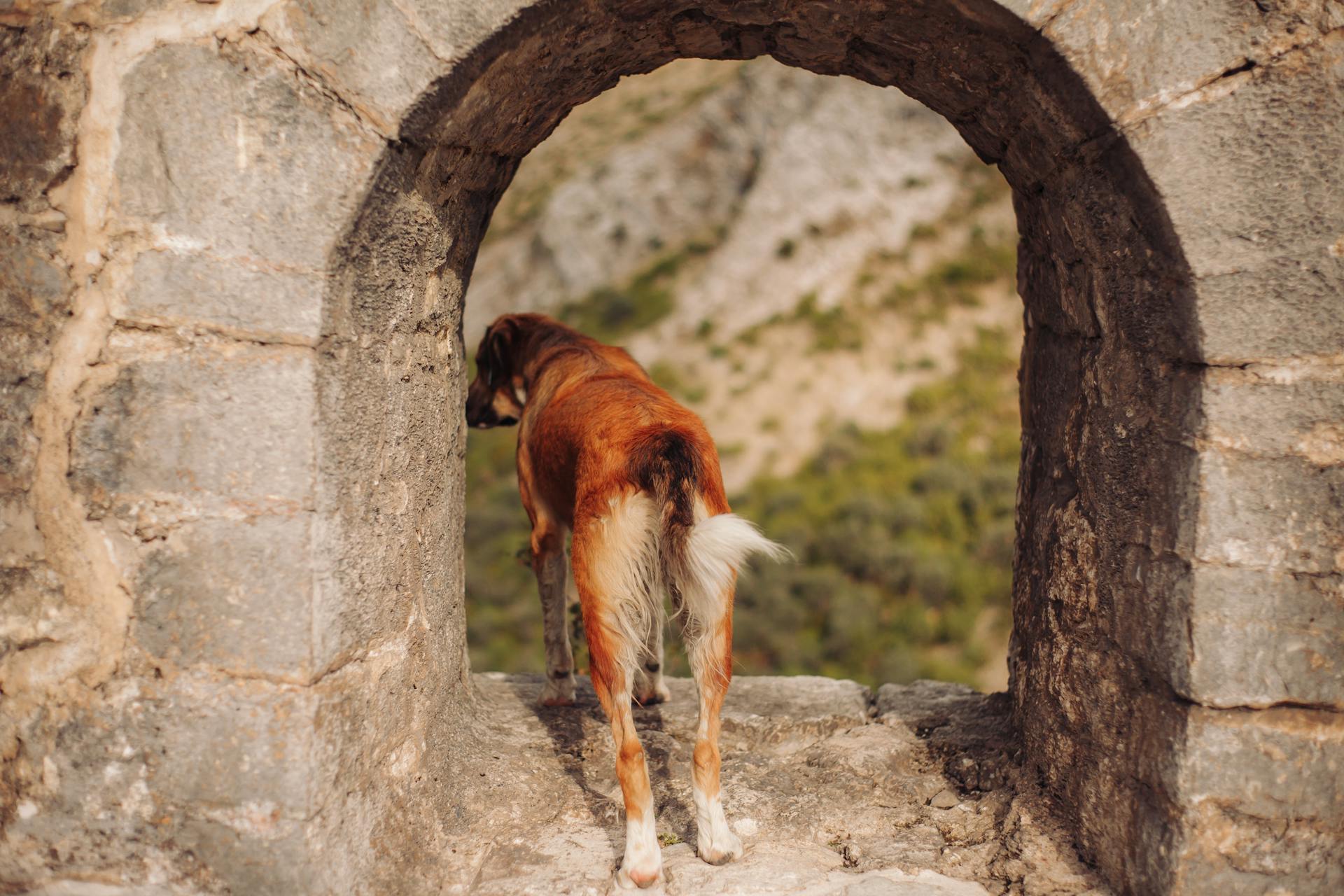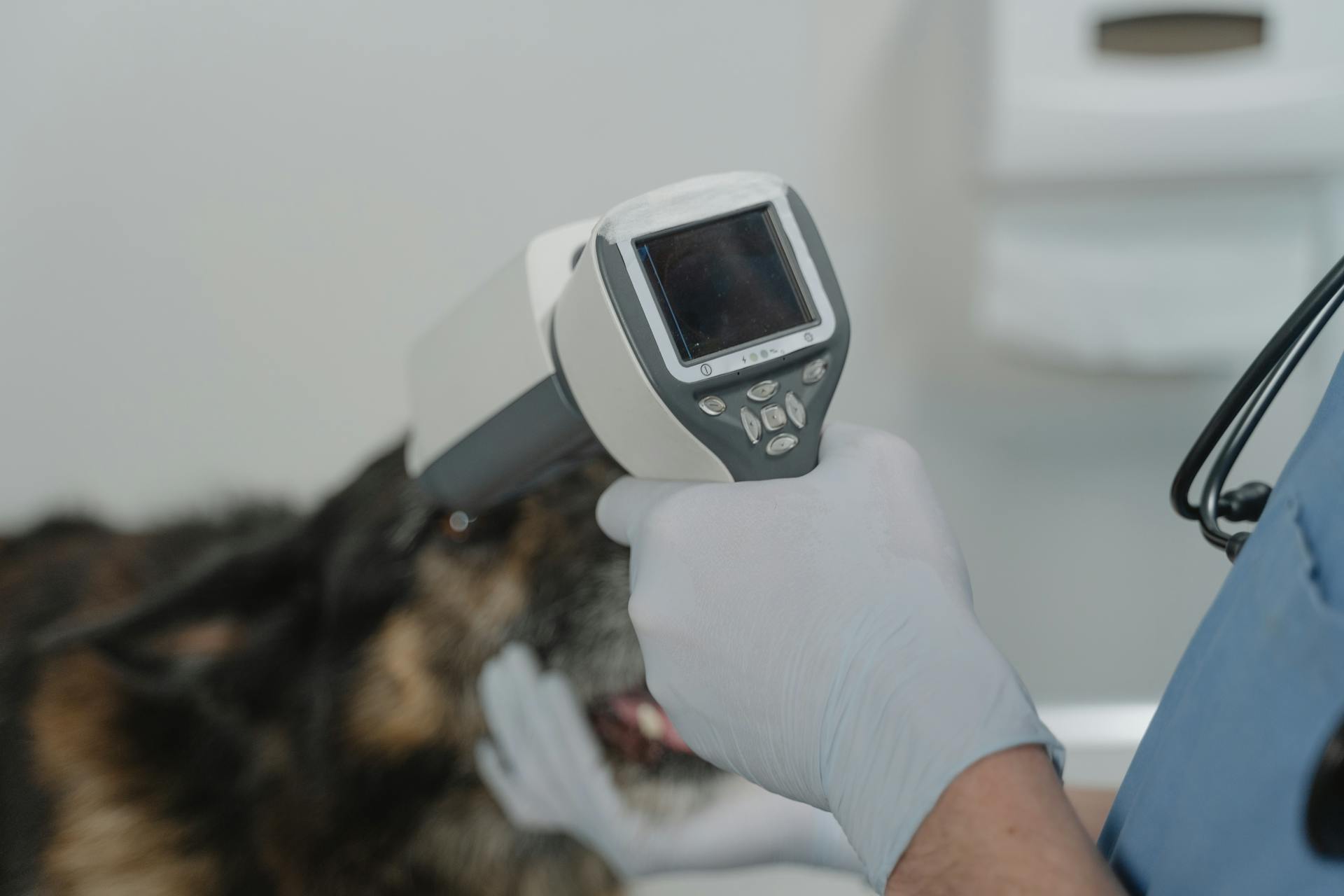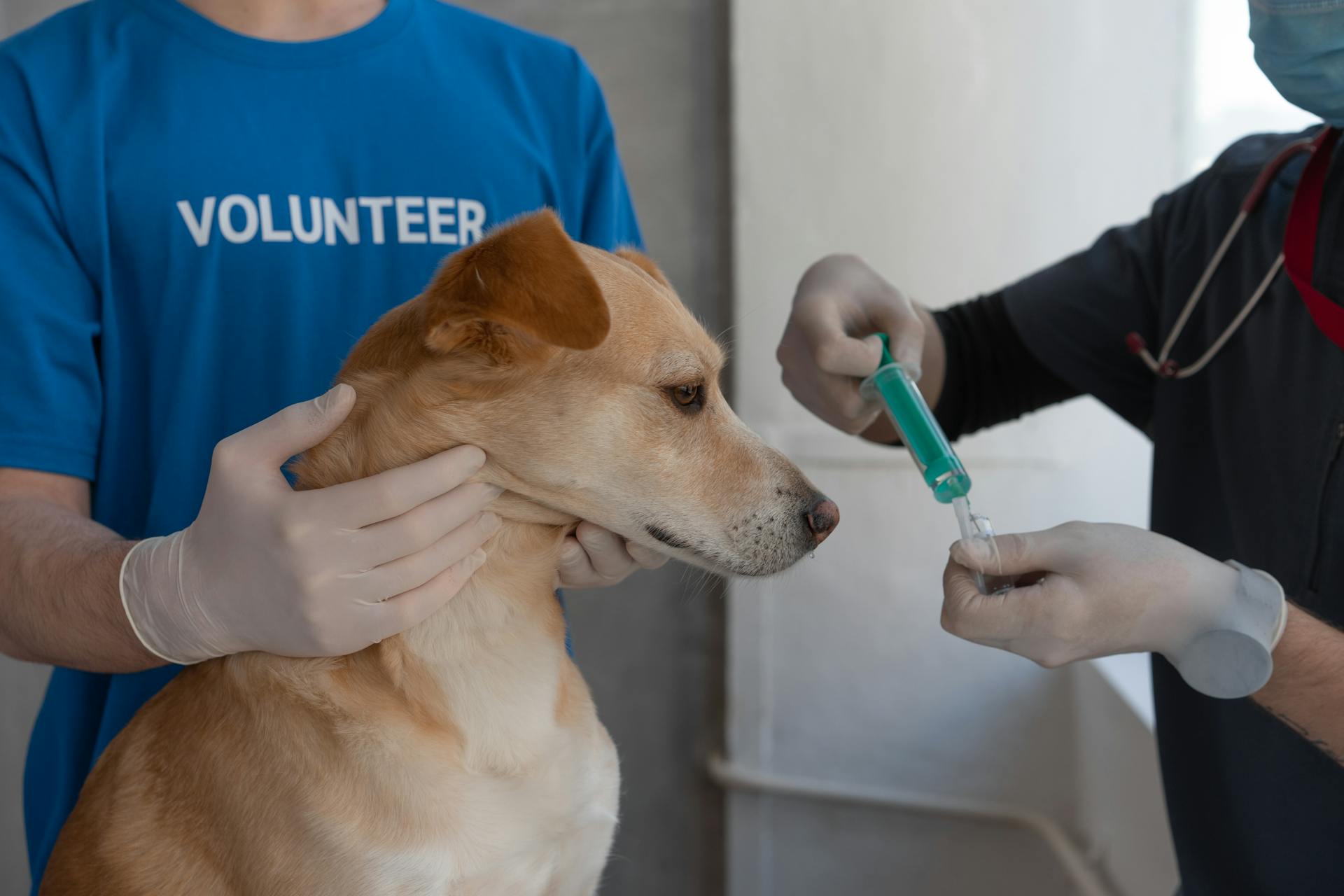
Dogs can develop bladder stones, which are hard mineral deposits that form inside the bladder. These stones can cause painful urination, bloody urine, and frequent trips to the vet.
Some common types of bladder stones in dogs include struvite stones, which are often caused by a diet high in protein and ash, and oxalate stones, which can be linked to a diet rich in oxalate-containing foods like spinach and beets.
Preventing bladder stones in dogs is crucial to avoid the pain and discomfort they cause. One way to do this is by feeding a balanced diet that's low in protein and ash.
Regular veterinary check-ups can also help catch any potential issues before they become serious.
You might enjoy: Is High Protein Dog Food Good for Dogs
Causes and Prevention
Female dogs are more prone to struvite bladder stones due to their shorter, wider urethra, which makes it easier for bacteria to travel up into the bladder.
Certain breeds, such as the cocker spaniel, miniature poodle, and shih tzu, are more susceptible to struvite stones.
Long-term use of diuretic drugs or antacids, and conditions that cause elevated urine pH, urinary phosphorus, or ammonia, can also predispose a dog to struvite bladder stones.
Diet plays a crucial role in preventing bladder stones from forming again, so it's essential to feed a nutritionally balanced food that's specifically designed to prevent stone formation.
Encouraging water intake is also vital, as crystals are less likely to form in dilute urine.
What Causes?
Bladder stones in dogs can be a real pain, both for the dog and the owner. They're caused by the formation of mineral crystals in the urine, which can be influenced by factors like diet and previous bladder conditions.
Diet plays a significant role in the formation of bladder stones. A diet high in certain minerals can increase the concentration of these minerals in the urine, making it more likely for crystals to form. By changing the diet, you can reduce the concentration of these minerals and create a less hospitable environment for bacteria to grow.

Struvite crystals are a common type of mineral crystal that can form in the urine. They're more likely to form in alkaline urine, which can be caused by bacterial infections or other underlying conditions. Female dogs are more prone to these types of infections, especially those with shorter, wider urethras.
Certain breeds are more susceptible to bladder stones. Small and toy breeds, such as the cocker spaniel and miniature poodle, are more likely to develop struvite stones. Other breeds, like the golden retriever and Labrador retriever, may also be at risk.
Here are some common causes of bladder stones in dogs:
- Struvite crystals in alkaline urine
- Bacterial infections
- Certain breeds (e.g., cocker spaniel, miniature poodle)
- Small and toy breeds
- Underlying conditions (e.g., kidney disease, long-term use of diuretic drugs or antacids)
Preventing What?
Preventing bladder stones in dogs requires a long-term commitment to a healthy diet. Manufacturers have formulated special foods that deter the formation of crystals in the urine.
Encouraging water intake is also crucial, as crystals are less likely to form in dilute urine. This is why many veterinarians recommend canned versions of these foods over dry.

Your pet's doctor is the best person to recommend a nutritionally complete, well-balanced food that will help keep your pet healthy. Regular vet checkups are essential to ensure your dog is not forming bladder stones again.
To prevent recurrence of bladder stones, it's essential to know how or why they formed in the first place and what the mineral content of the stones is. Further investigation may be required if your dog has had several bouts of infection.
Changing your dog's diet can have a significant impact on preventing bladder stones from recurring. A prescription diet can reduce the concentration of minerals that are an issue, alter the pH of the urine, and create a less hospitable environment for bacteria to grow.
Symptoms and Diagnosis
Symptoms of dog bladder stones can be similar to those of an uncomplicated bladder infection or cystitis. Dogs with bladder stones may exhibit symptoms such as hematuria (blood in the urine) and dysuria (straining to urinate).
The most common signs of bladder stones are hematuria, dysuria, and increased frequency to urinate (pollakiuria). These symptoms occur because the stones irritate and damage the bladder lining, causing bleeding and pain.
Dogs may also show signs of discomfort, such as being less active, panting more, eating less, or crying when urinating. If an obstruction occurs, the dog may strain to urinate, be lethargic, have a lack of appetite, and vomit.
Here are the three most common signs of bladder stones:
- Blood in the urine (Haematuria)
- Straining to urinate (Dysuria)
- Increased frequency to urinate (Pollakiuria)
If your veterinarian suspects bladder stones, they may recommend an X-ray or ultrasound examination to confirm the diagnosis. Some stones may not be visible on X-rays, in which case an ultrasound or contrast study may be necessary.
Signs Your Pet May Have an Issue
If your pet is showing signs of discomfort while urinating, it could be a sign of bladder stones. One of the most common signs is blood in the urine, also known as hematuria, which occurs when the stones irritate and damage the bladder lining.
Straining to urinate is another common sign, which can be caused by inflammation and swelling of the bladder walls or the urethra, muscle spasms, or a blockage in urine flow.
Dogs with bladder stones may also experience an increased frequency to urinate, known as pollakiuria, due to the stones inflaming and irritating the bladder walls.
Here are the three most common signs of bladder stones in dogs:
- Blood in the urine (Haematuria)
- Straining to urinate (Dysuria)
- Increased frequency to urinate (Pollakiuria)
If your pet is showing any of these signs, it's essential to seek veterinary attention as soon as possible to rule out other potential causes and confirm the diagnosis through imaging tests such as X-rays or ultrasounds.
How Will My Veterinarian Diagnose?
Your veterinarian will need to investigate further to diagnose bladder stones, as the symptoms can be similar to those of a bladder infection.
Most dogs with bladder stones do not have a bladder infection, so ruling out other possibilities is crucial.
Palpating the bladder to feel for stones may not be possible if the stones are too small or the bladder is too inflamed.
X-rays, an ultrasound, or a radiographic contrast study may be recommended to confirm the presence of bladder stones.
Some bladder stones are too small to be seen on X-rays, and in these cases, an ultrasound or contrast study may be necessary.
Struvite stones are almost always visible on a plain radiograph, but other body parts may interfere with the view.
In some cases, your veterinarian may recommend a bladder ultrasound or contrast study to get a clear view of the stones.
To confirm the type of stone, your veterinarian may need to have the stone analyzed at a veterinary laboratory.
Check this out: Stripping Stone
Treatment and Removal
Surgical removal is often recommended for dogs with many stones in their bladder, increased risk of urinary tract obstruction, or if the client wants a quick solution.
Male dogs are at a higher risk of developing urinary tract obstruction due to bladder stones, so surgery is often a strong recommendation for them.
Surgery is also indicated if dietary treatment doesn't work or if the stones are a mixture of mineral types.
If struvite is the diagnosis, a veterinarian will treat the underlying cause and may recommend a therapeutic diet to dissolve the stones and crystals.
Dogs prescribed antibiotics will typically use the drugs while consuming the therapeutic dog food, and possibly longer if needed.
Surgery or other procedures like lithotripsy will be necessary to get the stones out of the bladder if the therapeutic diet doesn't work.
There are two options for treatment: surgical removal and attempting to dissolve certain types of bladder stones with a specific diet.
Here are the advantages and disadvantages of each option:
Diet and Protocol
Feeding a special diet can help dissolve struvite bladder stones, especially when combined with increased water intake to dilute the urine.
These diets are typically restricted in protein, phosphorus, and magnesium, and formulated to promote acidic urine with a pH less than 6.5.
Examples of these diets include Hills Prescription Diet s/d, Royal Canin Urinary SO, Purina Pro Plan Veterinary UR Urinary, and Rayne Clinical Nutrition Adult Health-RSS.
Dissolution of the stones is further enhanced by increased water intake, which dilutes the urine and helps release bacteria trapped in the stone layers.
Antibiotic therapy is also crucial during the dissolution process to prevent new infections.
Follow-up X-rays and urinalysis are recommended every four to six weeks during treatment to monitor progress.
Some dogs may experience dissolution of struvite stones within two weeks, while others may take up to 12 weeks.
If the stones are not dissolving, it may indicate that they are mixed or composed of multiple layers of different minerals, requiring an adjusted treatment plan.
Commercially available diets that promote struvite stone dissolution typically have low protein, phosphate, and magnesium intake, and high sodium intake, resulting in osmotic diuresis and enhanced urine volume.
No other food, including treats, should be fed during this time, and adequate fresh water should be available at all times.
Urease-producing urinary tract infections must be treated with antibiotics, and a urease inhibitor can be given to enhance the rate of stone dissolution.
Take a look at this: Types of Dog Eye Infections
A reasonably safe dose of acetohydroxamic acid, a urease inhibitor, is 12.5 mg/kg, PO, bid.
Regular testing is crucial to monitor the stone dissolution protocol and adjust the treatment plan as needed.
The goal is to achieve and maintain sterile urine, which can be achieved through a combination of diet and treatment.
Prevention strategies are much more likely to be successful once the urinary tract is free of stones.
Frequently Asked Questions
How long can a dog last with bladder stones?
A dog with bladder stones can last several months before full dissolution, but this prolonged period comes with a high risk of urethral obstruction and continued symptoms. Treatment is usually necessary to alleviate suffering and prevent complications.
Sources
- https://vcahospitals.com/know-your-pet/struvite-bladder-stones-in-dogs
- https://www.petmd.com/dog/centers/nutrition/bladder-stones-in-dogs-what-are-the-signs-treament
- https://www.merckvetmanual.com/urinary-system/noninfectious-diseases-of-the-urinary-system-in-small-animals/urolithiasis-in-small-animals
- https://www.vetwest.com.au/pet-library/bladder-stones-in-dogs/
- https://www.greentrailsanimalclinic.com/site/blog/2023/11/15/bladder-stones-dogs
Featured Images: pexels.com


